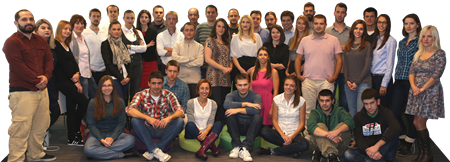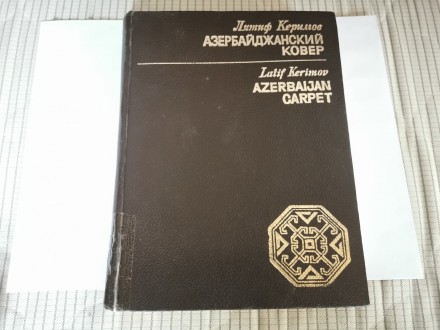Azerbaijan Carpet III - Latif Kerimov (ruski jezik)
| Cena: |
| Želi ovaj predmet: | 3 |
| Stanje: | Polovan bez oštećenja |
| Garancija: | Ne |
| Isporuka: | Pošta Post Express Lično preuzimanje |
| Plaćanje: | Tekući račun (pre slanja) Lično |
| Grad: |
Beograd-Mirijevo, Beograd-Zvezdara |
Godina izdanja: Ostalo
ISBN: Ostalo
Oblast: Dizajn
Jezik: Ruski
Autor: Strani
Baku
Azerbejdzanski tepisi 3
Godina : 1983
Veci format
Stranica : 303+144 stranice sa fotografijama tepiha u boji.
STanje : Solidno ocuvana, lepljena sa strane na prednjoj korici, kao na slici, kompaktna, cista unutrasnjost, sasvim u redu za citanje.
Ruski jezik.
Latif Karimov is an outstanding citizen of the nation, scientist, artist, carpet weaver, and author of the essential work Azerbaijani Carpet. He was born in 1906 in Shusha, the ancient city of Azerbaijan. His father, Mashhadi Huseyn, was a hatter, and his mother, Telli Hajinasib gizi, was one of Karabakh’s well-known weavers.
In 1912, the Karimov family moved to Mashhad, a city in Iran. Here, L. Karimov improved his painting skills by studying the classical oriental art of calligraphy, After finishing school in 1922, at the carpet workshop of Mirza Alakbar Huseynzadeh, Karimov first worked as an instructor’s assistant, then as an instructor, and later as an artist. After returning to Azerbaijan in 1929, he worked at Azerkhalcha Scientific and Creative Production Association.
In the 1930s, when a period of mass production started, Karimov drew classical carpet sketches and brought a number of innovations into the art of carpet weaving.
In 1937, on the initiative of Latif Karimov, the Central Dyeing Workshop in Baku opened. He was the first to create a scale of colors for carpets.
From 1945 until the end of his life, L. Karimov was the Head of the Decorative and Applied Art Department (from 1984 - Department of Carpet Art) at the Architecture and Art Institute of the National Academy of Sciences of Azerbaijan SSR. In 1950 he received his PhD in Art for his work Source of Ornaments on Azerbaijani Carpets.
Karimov was highly appreciated by the government. He was awarded the USSR State Prize in 1950, Honored Worker of Art in 1955, and People’s Artist in 1960.
Vreme preuzimanja je svake nedelje razlicito zbog posla, dogovor.
Kupljeni predmeti se salju dva do tri puta nedeljno, zavisno od obaveza. Na dan kada je isplata penzija ne saljem posiljke zbog guzve.
Komunikacija telefonom radnim danima posle 16h.
NE SALJEM POUZECEM.
***Na Kosovo i Metohiju saljem na vasu odgovornost, samo post expressom, postom nekada prave problem nazalost***
Ukoliko NISTE clan Limunda i Kupinda, mozete otvoriti nalog preko sledeceg linka :
https://www.limundo.com/ref/Skyhookbg
Pogledajte i moju ostalu ponudu na Kupindu
https://www.kupindo.com/Clan/Skyhookbg/SpisakPredmeta
Racun za uplatu je u Rajfajzen banci, nemam drugi sem tog, tako da imate u vidu.
LICNO PREUZIMANJE JE U MIRIJEVU, AKO IDETE PREVOZOM IDETE DO POSLEDNJE STANICE AUTOBUSA 27, 20 I 74, PA OKO 300 METARA IZNAD. JAVITE SE OKO DOGOVORA ZA PREUZIMANJE PA CEMO SE USKLADITI OKO TERMINA, SAMO NA ADRESI KOJU DOBIJETE SA SAJTA POSLE KUPOVINE, NISAM U MOGUCNOSTI DA SE NALAZIM NEGDE PO GRADU.
Pre kupovine procitajte opis predmeta, ako vam odgovara izvrsite kupovinu putem sajta.
Saljem, posle dogovora sa kupcem, postom ili post expressom, kupac snosi troskove slanja, sem ako nije naznaceno drugacije.
***NE ODGOVARAM AKO POSTA ZAGUBI POSILJKU PREKO IZNOSA KOJI MENI POSTA NAKNADI ZA POSILJKU.
Za vrednije stvari najbolje posiljka kao vrednosno pismo, sto kosta nesto vise i onda mogu da nadoknadim ceo iznos.***
Predmeti se salju iskljucivo PREPORUCENO (ako je slanje postom) zbog mogucnosti da se prati predmet i kao dokaz o slanju.
SALJEM U INOSTRANSTVO samo knjige i casopise, kao tiskovinu, po vazecem cenovniku Poste Srbije. Uplata jedino moguca putem Western Uniona.
Sve ostale predmete samo preko posrednika u Srbiji!
Ocekujem da me kupac kontaktira prvi kada kupi predmet i oceni prvi posle zavrsetka saradnje, kao sto i ja radim kada kupujem.
Molio bih da se postuju rokovi za kontakt i uplatu propisani Limundo i Kupindo pravilnikom.
Ako se, bez opravdanog razloga, ne pridrzavate rokova, sledi negativna ocena.
Molim Vas da se komunikacija odvija putem kupindo/limundo poruka, samo izuzetno porukama preko mobilnog telefona.
Sve se mozemo dogovoriti i uvek sam tu za svaku saradnju i odgovor na svako pitanje.
Predmet: 64645141













